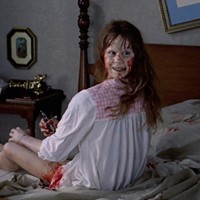Fur, devil horns, and a taste for children’s flesh: we unravel the myth behind Europe’s original bad Santa
From medieval times comes a mythical beast: the legendary Krampus. Half-goat, half-devil, he’s an anti-St. Nicholas that swats and punishes naughty children before hauling them back to his lair in a basket and eating them for Christmas dinner.
In the folklore of Western Europe, Krampus shows up on December 6 for Krampus Night with Santa Claus. While jolly old St. Nick hands out sweets and gifts, Krampus targets the children who were too wicked to get presents. The tradition has taken on a more modern role around the world with Krampuslauf or Krampus Run, where men dressed as the horned devil drunkenly cavort through the streets chasing residents and causing chaotic merriment.
The pagan holiday tradition, which was co-opted by the Christian religion in the 17th century, has been suppressed for many years – but it’s now making a comeback. Krampus has been featured in Hollywood movies, books and even TV shows. LA journalist and Krampus enthusiast Al Ridenour penned a tome on the Christmas devil, The Krampus And The Old, Dark Christmas Roots and Rebirth of the Folkloric Devil, out now on Feral House. Dazed talked to him about the legend of Krampus, why he looks so fierce, and what naughty children can expect this holiday season.
When and where did the legend of Krampus originate?
Al Ridenour: That’s a question I devote 150 of my book to answering, so it’s hard to give you a short answer. As for the “where,” however, it’s pretty straightforward. He’s a creature of the eastern half of Austria, the Alpine region, and Bavaria, the neighbouring part of Germany. The name, “Krampus,” is actually pretty modern. It only goes back to the mid-1800s or so, but we see similar seasonal appearances of devilish or monstrous costumed characters quite a bit earlier. A case could be made that these customs could even be traced the Roman celebrations of Kalends at the turn of the year, where we hear of people dressed in animal skins or as horned beasts going door to door.
“Parents have used these sort of playfully constructed, threatening figures to keep children in line. Usually, they are shadowy and vaguely defined figures, more effective because they leave so much the terrified imagination of the child” – Al Ridenour
How did the legend interact with the folklore of the Germanic people?
Al Ridenour: There are lots of connections between the Krampus folklore and the rest of the mythology of German-speaking lands. He’s related to a variety of vaguely defined spooks or bogeyman characters. The wild Krampus run, or Krampuslauf, may be a sort of enactment of the folklore of the Wild Hunt, or Furious Army – names folklorists use for fearsome apparitions of ghosts or devils said to swarm in the skies or through towns or forests particularly around the Christmas season. He’s even related to a female witch-like figure, Frau Perchta, who Jacob Grimm discussed as a cousin of the German fairy figure Frau Holle.
Describe the fierce appearance of Krampus. Why was he so frightening?
Al Ridenour: He was frightening because parents, and to a lesser extent, the Church needed him to be. I say, to a lesser extent, because the figure’s more a creation of the people than the Church, so really he’s the product of a sort of grassroots folk Catholicism. At his simplest, he’s just a bogeyman used to encourage good behaviour. Until the last 100 years or so – and for millennia perhaps – parents have used these sort of playfully constructed, threatening figures to keep children in line. Usually, they are shadowy and vaguely defined figures, more effective because they leave so much the terrified imagination of the child.
The Krampus is related to another German figure, ‘The Man with the Sack’, who is at least as old as the 1600s. He’s also fairly vaguely defined. His name, and the fact that the sack was used like the Krampus’ basket to haul away bad kids, is pretty much all there is to him. The Krampus is one of these types of characters. Horns and fur may have been added thanks in part to Church iconography of the Devil, but his appearance was also the product of whatever materials might be found on an Alpine farm. Goat hides and horns were pretty easy to come by on Alpine farms, and so his fur and horns became iconic.

Are there any legends of Krampus actually delivering gifts or anything contrary like that?
Al Ridenour: No. However, there’s a fairly equivalent figure further north in Germany called Knecht Ruprecht (‘Servant Ruprecht’), who appears alongside St. Nicholas as a punisher of naughty children. Rather than a furry devil, he’s represented as black-bearded man in a dark, rough robe, and he carries switches, more as symbolic threat than as an instrument he uses himself. In some regions, he has also been known to bring gifts. In Protestant regions, the idea that Nicholas is an actual saint of the Church is forgotten, and there once were a number of strange, ambivalent hybrid figures that fused the gift-bringer with the more frightening, wild punisher. They went by various names, some of which, in English would be translated as ‘Rough Nicholas.’
Do you think Krampus is getting too commercialised?
Al Ridenour: I’ve written a book I’m eager to sell, and I produce a series of Krampus events in LA, so I don’t think there’s anything wrong with feeding a hungry market. I just don’t want to feed that market junk food. I want to see them get the real thing. To me, the authentic folklore is the most fascinating, but most of the comic books and movies Americans are consuming completely misrepresent the figure. It’s natural that folklore evolves, and America may be developing its own indigenous version of the Krampus, but to not understand what the character’s actually based on seems a shame.
In Europe there is also a problem with Krampus runs becoming too large, requiring the city to step in and exert control, erect barricades separating performers and spectators, ban the use of burning torches or other pyrotechnic effects once used by Krampus troupes, and so forth. That also seems unfortunate, if inevitable.
The interview has been edited and condensed for length. Al Ridenour’s book, The Krampus And The Old, Dark Christmas Roots and Rebirth of the Folkloric Devil, is available to buy now



